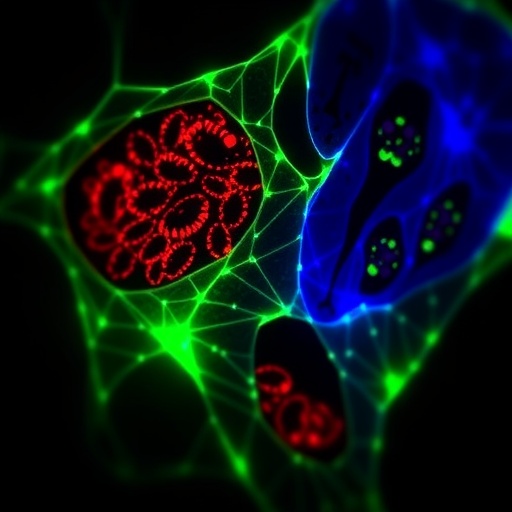In a groundbreaking study poised to redefine our understanding of ovarian cancer metabolism, researchers have unveiled a novel molecular mechanism by which cellular behaviors are orchestrated through the dynamic process of phase separation. This pivotal discovery highlights how the RNA-binding protein hnRNPL forms discrete liquid-like condensates that act as transcriptional activators for the crucial oncogene PIK3CB, consequently fueling enhanced glycolytic activity within malignant ovarian cells. Published recently in Nature Communications, these findings not only illuminate the intricate biochemical landscapes of cancer cell regulation but also open new therapeutic avenues to disrupt tumor metabolism at its core.
The phenomenon of phase separation has emerged in recent years as a fundamental organizational principle wherein biomolecules spontaneously demix from the surrounding milieu to form concentrated membraneless compartments. This physicochemical behavior grants cells a sophisticated method to spatially regulate biochemical reactions, facilitating rapid and reversible assemblies that control gene expression, signal transduction, and stress responses. Yet, the role of phase separation in directly modulating oncogenic transcription factors and metabolic pathways had remained elusive—until now.
The study focuses on heterogeneous nuclear ribonucleoprotein L (hnRNPL), a multifaceted RNA- and DNA-binding protein previously implicated in diverse post-transcriptional regulatory functions. Qin, Wang, Yang, and colleagues methodically demonstrate that hnRNPL undergoes phase separation under physiological conditions, forming biomolecular condensates that recruit chromatin-modifying complexes. This process orchestrates a transcriptional upregulation of PIK3CB, a catalytic subunit of phosphoinositide 3-kinase (PI3K), itself a well-characterized driver of oncogenic signaling and metabolic reprogramming.
PIK3CB’s upregulation initiates a cascade of intracellular events culminating in heightened glycolysis—the biochemical conversion of glucose to lactate despite oxygen availability, a metabolic hallmark dubbed the Warburg effect. This metabolic shift provides cancer cells with both anabolic precursors needed for rapid proliferation and an environment conducive to evading apoptotic signals. By establishing a direct mechanistic link between hnRNPL phase separation and PIK3CB-driven glycolytic enhancement, this work captures the molecular intricacies underpinning ovarian tumor aggressiveness.
The researchers employed cutting-edge imaging techniques including live-cell fluorescence microscopy and super-resolution methods to visualize hnRNPL condensate formation in situ. These analyses revealed that the phase-separated droplets dynamically assemble and disassemble in response to cellular stimuli typical of cancer progression, such as hypoxia and metabolic stress. The ability of hnRNPL condensates to transiently scaffold epigenetic activators at the PIK3CB gene locus underscores a novel layer of transcriptional control driven by biophysical compartmentalization rather than static DNA-protein interactions alone.
Biochemical and biophysical assays further elucidated the molecular determinants governing hnRNPL phase behavior, pinpointing intrinsically disordered regions and specific RNA interactions as key modulators of condensate dynamics. Mutation or pharmacological targeting of these domains abrogated both condensate formation and PIK3CB transcriptional induction, providing compelling proof of concept that phase separation is indispensable for hnRNPL’s oncogenic function. These insights suggest potential strategies to design small molecules capable of disrupting pathological phase transitions as a therapeutic intervention.
These findings resonate beyond ovarian cancer, hinting that phase separation-mediated transcriptional modulation could be a general mechanism employed by various malignancies to adapt their metabolic circuitry. Given PI3K signaling’s broad involvement in multiple tumor types and hnRNPL’s widespread expression, the implications of this regulatory paradigm are vast and warrant further exploration. Understanding how such condensates integrate extracellular cues to reprogram gene expression and metabolism could reveal fundamental principles of cancer resilience and plasticity.
Importantly, this research challenges traditional drug discovery approaches that target static protein domains or single enzymes by emphasizing the disruption of dynamic biomolecular assemblies. Therapeutics designed to modulate phase separation hold promise to achieve unprecedented specificity and efficacy, attacking cancer’s adaptive hubs rather than its individual molecular components. Such strategies may particularly benefit patients with ovarian tumors resistant to existing PI3K inhibitors, offering a new lifeline by dismantling the physical infrastructure underpinning oncogenic transcription.
The interdisciplinary approach combining cell biology, biophysics, genomics, and metabolism exemplifies the power of integrative science in tackling complex diseases. The study leverages advances in optogenetics and single-molecule tracking to dissect condensate kinetics, while transcriptomic and proteomic profiling clarifies downstream effects, ensuring a comprehensive picture of hnRNPL’s multifaceted role. This holistic methodology sets a new standard for mechanistic studies in cancer biology.
Moving forward, in vivo models will be indispensable to validate the pathological significance of hnRNPL phase separation in tumor growth, metastasis, and therapeutic resistance. Patient-derived xenografts and genetically engineered mouse models targeting hnRNPL’s condensate-forming domains may provide critical insights into how this process influences clinical outcomes. Furthermore, clinical correlations between hnRNPL expression, PIK3CB activation, and metabolic markers could establish prognostic or predictive biomarkers guiding personalized cancer therapy.
The delicate balance governing phase separation dynamics also raises intriguing questions about the physiological roles of hnRNPL condensates in normal tissues and how perturbations lead to disease. It remains to be elucidated whether similar transcriptional condensates participate in ovarian tissue homeostasis or stress adaptation, and how tumorigenic mutations hijack these processes. Deciphering these nuances will enhance our ability to selectively target pathological condensates while sparing normal cellular functions.
In summary, this transformative study bridges the gap between biophysical phase separation and metabolic oncogenesis, revealing hnRNPL as a master regulator that orchestrates PIK3CB transcription and glycolytic reprogramming through liquid-liquid phase separation. These revelations profoundly advance our understanding of ovarian cancer biology and chart a compelling path towards innovative therapies aimed at the biophysical underpinnings of malignancy. As the field of phase separation biology continues to mature, its integration with cancer metabolism promises to unlock novel dimensions of tumor biology and treatment.
Subject of Research: hnRNPL phase separation-driven transcriptional activation of PIK3CB and metabolic reprogramming in ovarian cancer.
Article Title: hnRNPL phase separation activates PIK3CB transcription and promotes glycolysis in ovarian cancer.
Article References:
Qin, F., Wang, Y., Yang, C. et al. hnRNPL phase separation activates PIK3CB transcription and promotes glycolysis in ovarian cancer. Nat Commun 16, 4828 (2025). https://doi.org/10.1038/s41467-025-60115-7
Image Credits: AI Generated
Tags: biochemical landscapes of cancerglycolysis enhancement in ovarian cancerhnRNPL and PIK3CB interactionliquid-like condensates in cellular processesmetabolic pathways in malignant cellsoncogene activation in cancerovarian cancer metabolism mechanismsphase separation in cancer cellspost-transcriptional regulation in cancer biologyRNA-binding proteins in oncologytherapeutic targets for ovarian cancertranscriptional regulation in tumor cells





